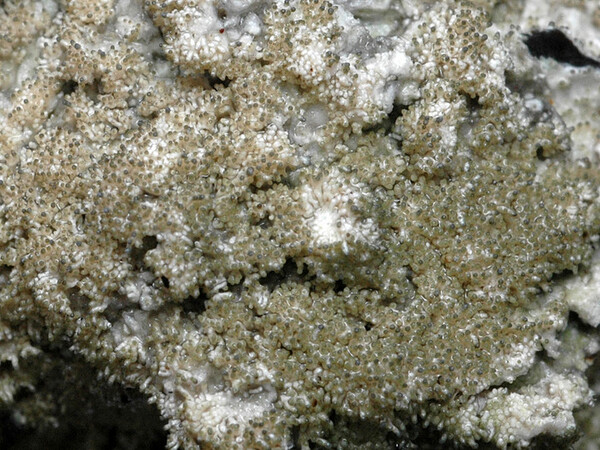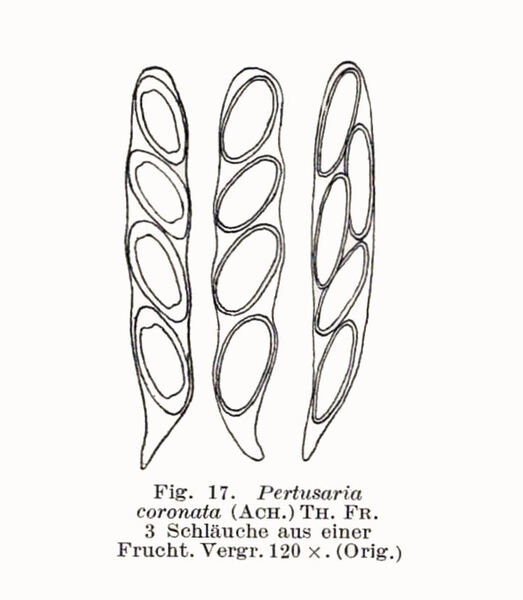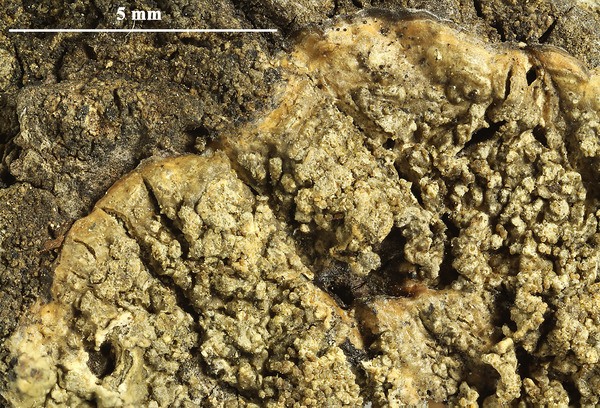Pertusaria coronata (Ach.) Th. Fr.
Lichenogr. Scand., 1: 321, 1871. Basionym: Porina coronata Ach. - Lichenogr. Univ.: 310, 1810.
Synonyms: Pertusaria coronata var. isidiifera (Erichsen) Almb.; Pertusaria isidiifera Erichsen
Distribution: N - Frl, Ven (Lazzarin 1997, Nascimbene & al. 2005b, 2006c, 2007, 2008c), TAA (Nascimbene 2008b), Lomb (Gheza & al. 2023), VA (Valcuvia 2000, Valcuvia & al. 2000b), Emil (Tretiach & al. 2008, Fariselli & al. 2020), Lig (Giordani & al. 2009, Giordani & Incerti 2008). C - Tosc (Benesperi & al. 2007), Umb (Panfili 2000b, Ravera & al. 2006), Abr (Di Santo & Ravera 2012, Corona & al. 2016, Gheza & al. 2021), Mol (Paoli & al. 2015), Sar (Rizzi & al. 2011, Di Nuzzo & al. 2022). S - Si.
Description: Thallus crustose, episubstratic, continuous to cracked or verrucose, grey-green to pale yellowish grey, sometimes delimited by a thin, white, glossy prothalline line, forming up to 10 cm wide patches, isidiate. Isidia concolorous with thallus, often darker at tips, cylindrical, rarely ovoid or subglobose, usually simple, 0.2-0.5(-1) mm long and 0.1-0.2 mm thick, leaving pale yellowish to white, punctiform scars when shed. Apothecia rare, verruciform-perithecioid, completely immersed in basally constricted thalline warts, opening through a small black pore, 1-4 per fertile wart. Asci (2-)4-spored, broadly cylindrical, the apex with a broad ocular chamber, the outer sheath K/I+ blue, otherwise K/I-, with an inner extensible layer, Pertusaria-type. Ascospores 1-celled, hyaline, ellipsoid, 90-160 x 45-70 µm. Photobiont chlorococcoid. Spot tests: K+ yellow to orange turning dirty orange-brown, C-, KC+ (sometimes faintly) yellow, P+ ochraceous orange, UV+ yellow-orange. Chemistry: 4,5-dichlorolichexanthone and stictic acid (major), constictic, cryptostictic, norstictic, hypostictic acids and atranorin (minor or traces). Note: a mild-temperate lichen found on bark of deciduous trees below the subalpine belt. Easily mistaken with the chemically different P. coccodes, and perhaps more widespread.
Growth form: Crustose
Substrata: bark
Photobiont: green algae other than Trentepohlia
Reproductive strategy: mainly asexual, by isidia, or isidia-like structures (e.g. schizidia)
Commonnes-rarity: (info)
Alpine belt: absent
Subalpine belt: absent
Oromediterranean belt: absent
Montane belt: rare
Submediterranean belt: extremely rare
Padanian area: absent
Humid submediterranean belt: very rare
Humid mediterranean belt: extremely rare
Dry mediterranean belt: absent
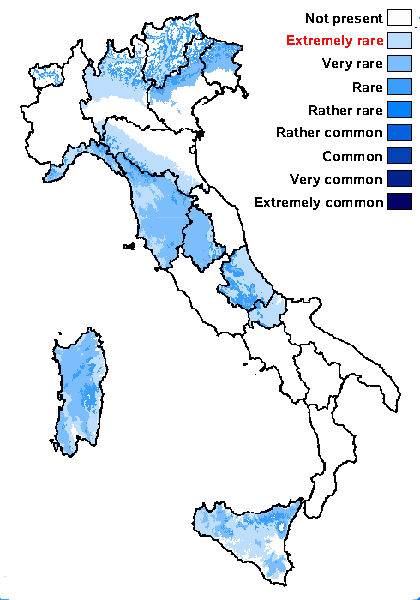
Predictive model
Herbarium samples
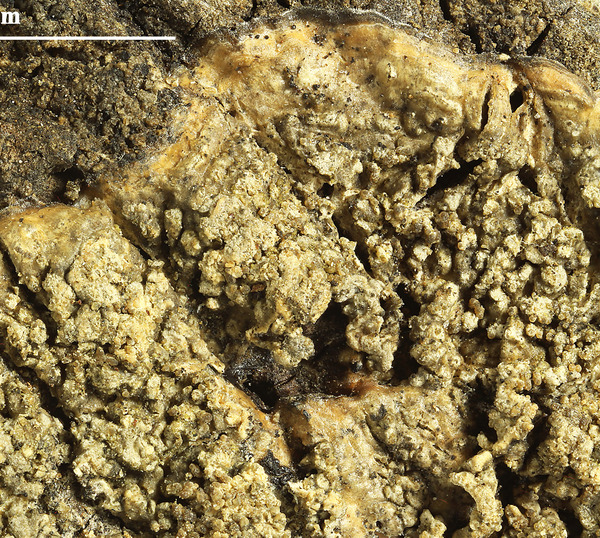

Felix Schumm - CC BY-SA 4.0
[1329], Germany, Baden-Württemberg, Kreis Göppingen, Göppingen, im Oberholz am Dreikönigsweg zwischen dem früheren Altersheim und dem Waldheim, an Laubbaum, ca. 380 m, TK 7223. Leg.Schumm 02.04.1970, det. V. Wirth
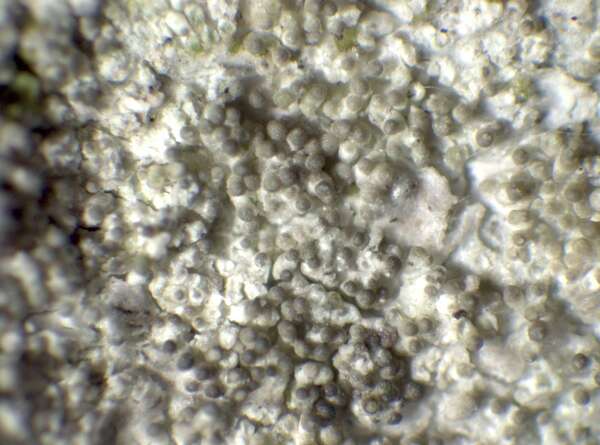

P.L. Nimis; Owner: Department of Life Sciences, University of Trieste
Herbarium: TSB (34869)
2002/02/17
isidia
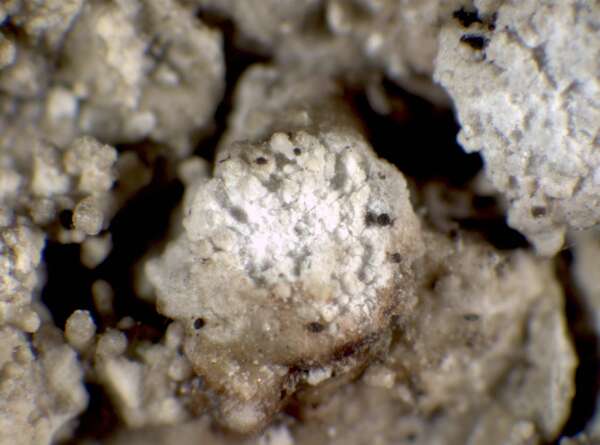

P.L. Nimis; Owner: Department of Life Sciences, University of Trieste
Herbarium: TSB (29296)
2001/12/10
apothecium


P.L. Nimis; Owner: Department of Life Sciences, University of Trieste
Herbarium: TSB (29296)
2001/12/10
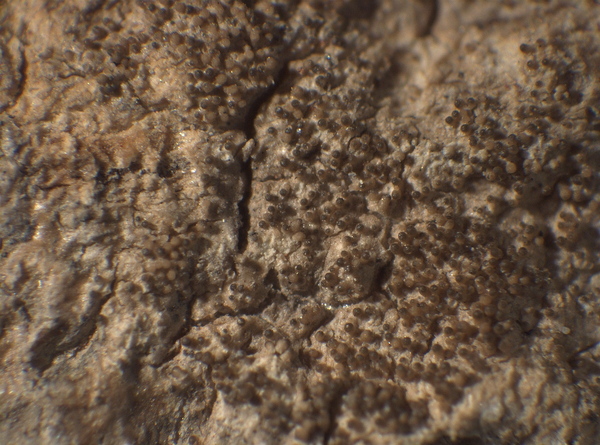

E. Pittao; Owner: Department of Life Sciences, University of Trieste
Herbarium: TSB (16226)
2008.03.10
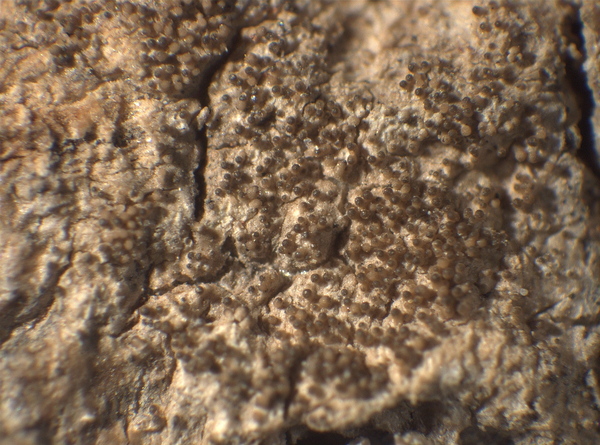

E. Pittao; Owner: Department of Life Sciences, University of Trieste
Herbarium: TSB (16226)
2008.03.10
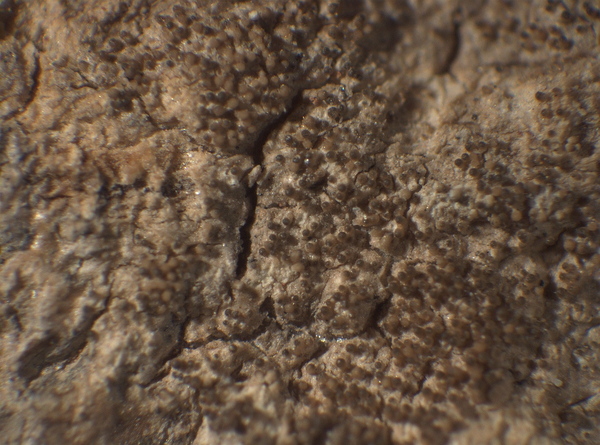

E. Pittao; Owner: Department of Life Sciences, University of Trieste
Herbarium: TSB (16226)
2008.03.10
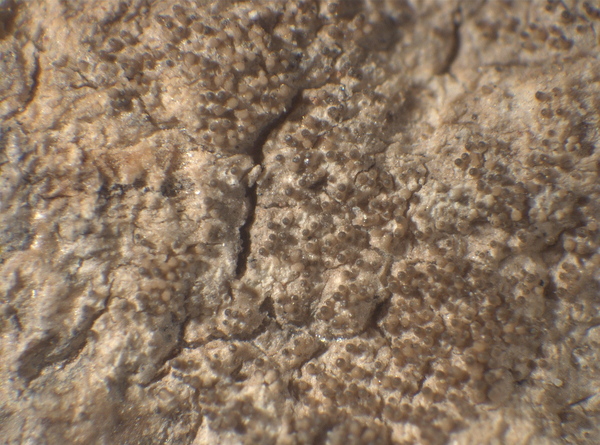

E. Pittao; Owner: Department of Life Sciences, University of Trieste
Herbarium: TSB (16226)
2008.03.10
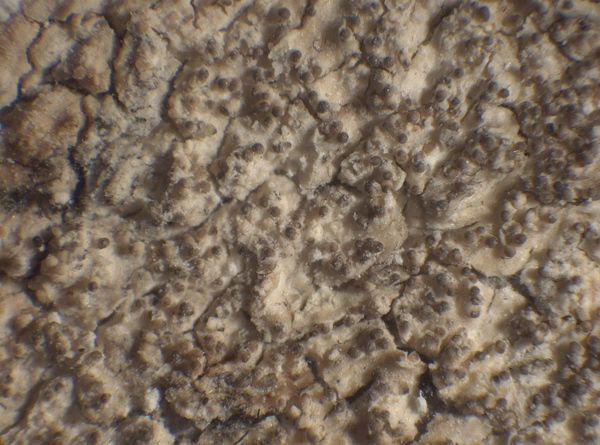

E. Pittao; Owner: Department of Life Sciences, University of Trieste
Herbarium: TSB (15091)
2008.03.10
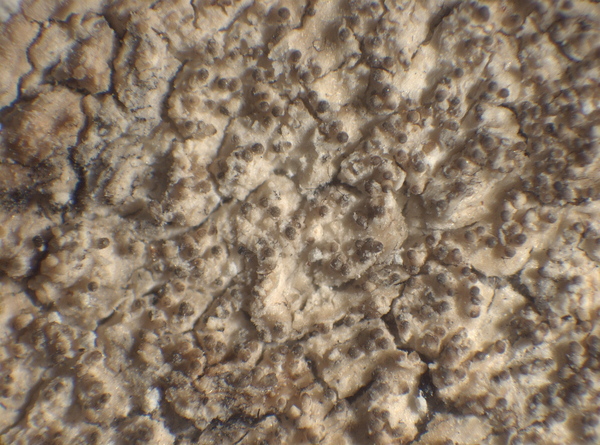

E. Pittao; Owner: Department of Life Sciences, University of Trieste
Herbarium: TSB (15091)
2008.03.10
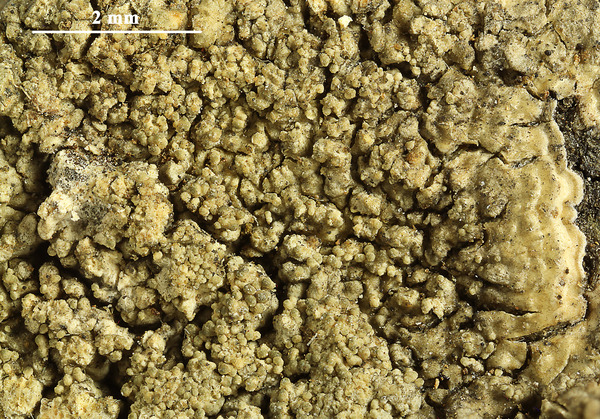

Felix Schumm - CC BY-SA 4.0
[1329], Germany, Baden-Württemberg, Kreis Göppingen, Göppingen, im Oberholz am Dreikönigsweg zwischen dem früheren Altersheim und dem Waldheim, an Laubbaum, ca. 380 m, TK 7223. Leg.Schumm 02.04.1970, det. V. Wirth
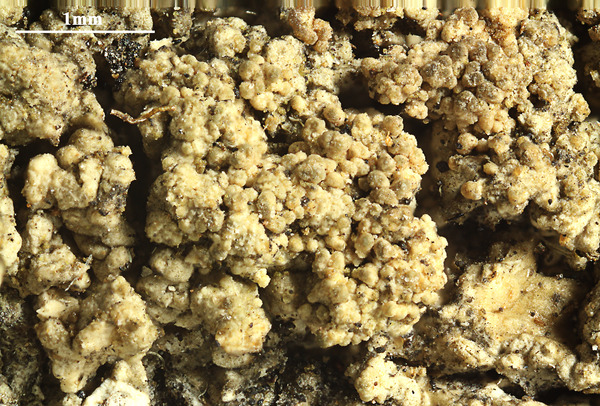

Felix Schumm - CC BY-SA 4.0
[1329], Germany, Baden-Württemberg, Kreis Göppingen, Göppingen, im Oberholz am Dreikönigsweg zwischen dem früheren Altersheim und dem Waldheim, an Laubbaum, ca. 380 m, TK 7223. Leg.Schumm 02.04.1970, det. V. Wirth


Felix Schumm - CC BY-SA 4.0
[1329], Germany, Baden-Württemberg, Kreis Göppingen, Göppingen, im Oberholz am Dreikönigsweg zwischen dem früheren Altersheim und dem Waldheim, an Laubbaum, ca. 380 m, TK 7223. Leg.Schumm 02.04.1970, det. V. Wirth
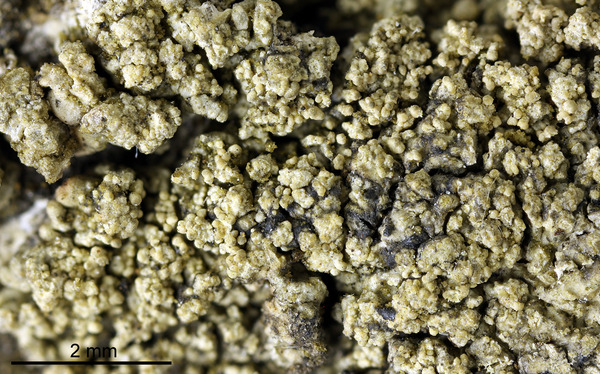

Felix Schumm - CC BY-SA 4.0
[1329], Germany, Baden-Württemberg, Kreis Göppingen, Göppingen, im Oberholz am Dreikönigsweg zwischen dem früheren Altersheim und dem Waldheim, an Laubbaum, ca. 380 m, TK 7223. Leg.Schumm 02.04.1970, det. V. Wirth


Felix Schumm - CC BY-SA 4.0
[1329], Germany, Baden-Württemberg, Kreis Göppingen, Göppingen, im Oberholz am Dreikönigsweg zwischen dem früheren Altersheim und dem Waldheim, an Laubbaum, ca. 380 m, TK 7223. Leg.Schumm 02.04.1970, det. V. Wirth
1: coronaton (= 4,5-dichlorolichexanthone), 2: stictic acid, 4: connorstictic acid, 5: cryptostictic acid, 6: constictic acid, 3,7,8,9: unknown, conf. J.A. Elix


Felix Schumm - CC BY-SA 4.0
Germany, Baden-Württemberg, NO von Hartmannsweiler Gemeinde Winnenden, Weinbergshang Himmelreich des Hörnle, an Quercus auf der Kuppe nahe dem Polypodiumvorkommen, ca. 370 m, TK 7122. Leg. et det. F. Schumm 14.06.1990.
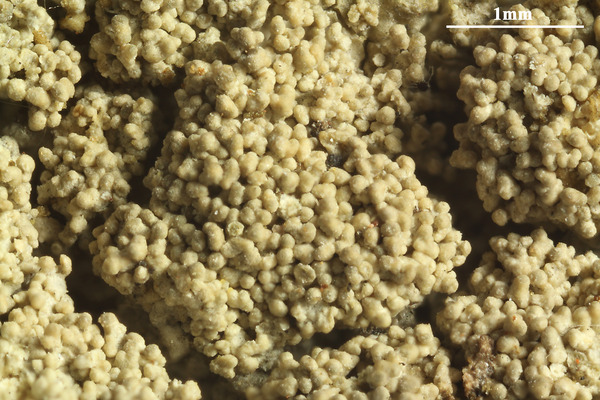

Felix Schumm - CC BY-SA 4.0
Germany, Baden-Württemberg, NO von Hartmannsweiler Gemeinde Winnenden, Weinbergshang Himmelreich des Hörnle, an Quercus auf der Kuppe nahe dem Polypodiumvorkommen, ca. 370 m, TK 7122. Leg. et det. F. Schumm 14.06.1990.
Growth form: Crustose
Substrata: bark
Photobiont: green algae other than Trentepohlia
Reproductive strategy: mainly asexual, by isidia, or isidia-like structures (e.g. schizidia)
Commonnes-rarity: (info)
Alpine belt: absent
Subalpine belt: absent
Oromediterranean belt: absent
Montane belt: rare
Submediterranean belt: extremely rare
Padanian area: absent
Humid submediterranean belt: very rare
Humid mediterranean belt: extremely rare
Dry mediterranean belt: absent

Predictive model
| Herbarium samples |


Felix Schumm - CC BY-SA 4.0
[1329], Germany, Baden-Württemberg, Kreis Göppingen, Göppingen, im Oberholz am Dreikönigsweg zwischen dem früheren Altersheim und dem Waldheim, an Laubbaum, ca. 380 m, TK 7223. Leg.Schumm 02.04.1970, det. V. Wirth


P.L. Nimis; Owner: Department of Life Sciences, University of Trieste
Herbarium: TSB (34869)
2002/02/17
isidia


P.L. Nimis; Owner: Department of Life Sciences, University of Trieste
Herbarium: TSB (29296)
2001/12/10
apothecium


P.L. Nimis; Owner: Department of Life Sciences, University of Trieste
Herbarium: TSB (29296)
2001/12/10


E. Pittao; Owner: Department of Life Sciences, University of Trieste
Herbarium: TSB (16226)
2008.03.10


E. Pittao; Owner: Department of Life Sciences, University of Trieste
Herbarium: TSB (16226)
2008.03.10


E. Pittao; Owner: Department of Life Sciences, University of Trieste
Herbarium: TSB (16226)
2008.03.10


E. Pittao; Owner: Department of Life Sciences, University of Trieste
Herbarium: TSB (16226)
2008.03.10


E. Pittao; Owner: Department of Life Sciences, University of Trieste
Herbarium: TSB (15091)
2008.03.10


E. Pittao; Owner: Department of Life Sciences, University of Trieste
Herbarium: TSB (15091)
2008.03.10


Felix Schumm - CC BY-SA 4.0
[1329], Germany, Baden-Württemberg, Kreis Göppingen, Göppingen, im Oberholz am Dreikönigsweg zwischen dem früheren Altersheim und dem Waldheim, an Laubbaum, ca. 380 m, TK 7223. Leg.Schumm 02.04.1970, det. V. Wirth


Felix Schumm - CC BY-SA 4.0
[1329], Germany, Baden-Württemberg, Kreis Göppingen, Göppingen, im Oberholz am Dreikönigsweg zwischen dem früheren Altersheim und dem Waldheim, an Laubbaum, ca. 380 m, TK 7223. Leg.Schumm 02.04.1970, det. V. Wirth


Felix Schumm - CC BY-SA 4.0
[1329], Germany, Baden-Württemberg, Kreis Göppingen, Göppingen, im Oberholz am Dreikönigsweg zwischen dem früheren Altersheim und dem Waldheim, an Laubbaum, ca. 380 m, TK 7223. Leg.Schumm 02.04.1970, det. V. Wirth


Felix Schumm - CC BY-SA 4.0
[1329], Germany, Baden-Württemberg, Kreis Göppingen, Göppingen, im Oberholz am Dreikönigsweg zwischen dem früheren Altersheim und dem Waldheim, an Laubbaum, ca. 380 m, TK 7223. Leg.Schumm 02.04.1970, det. V. Wirth


Felix Schumm - CC BY-SA 4.0
[1329], Germany, Baden-Württemberg, Kreis Göppingen, Göppingen, im Oberholz am Dreikönigsweg zwischen dem früheren Altersheim und dem Waldheim, an Laubbaum, ca. 380 m, TK 7223. Leg.Schumm 02.04.1970, det. V. Wirth
1: coronaton (= 4,5-dichlorolichexanthone), 2: stictic acid, 4: connorstictic acid, 5: cryptostictic acid, 6: constictic acid, 3,7,8,9: unknown, conf. J.A. Elix


Felix Schumm - CC BY-SA 4.0
Germany, Baden-Württemberg, NO von Hartmannsweiler Gemeinde Winnenden, Weinbergshang Himmelreich des Hörnle, an Quercus auf der Kuppe nahe dem Polypodiumvorkommen, ca. 370 m, TK 7122. Leg. et det. F. Schumm 14.06.1990.


 INDEX FUNGORUM
INDEX FUNGORUM
 GBIF
GBIF
 DOLICHENS
DOLICHENS
